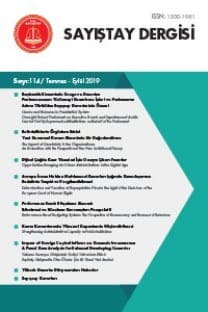Kamu Kurumlarında Mali Tablo Analiz Yöntemlerinin Uygulanabilirliği
Şeffaflık ve hesap verebilirlik demokrasilerde kamu mali yönetiminin kalitesine katkı sağlamaktadır. Özellikle son dönemde karmaşık devlet faaliyetlerinin kamuoyunca bilinmesine yönelik uygulamalar gelişmiş ve sorumluların faaliyetleri neticesinde hesap verebilecekleri mekanizmalar geliştirilmiştir. Kamu mali yönetiminde şeffaflık ve hesap verebilirliğe katkı sağlayan uygulamalardan bir tanesi kapsamlı bir kayıt ve raporlama imkânı sunan muhasebe sistemidir. Muhasebe sistemi aracılığıyla üretilen mali tabloların ilgili taraflarca incelenmesi ve analiz edilmesi sonucunda idarelerin mali durumu, faaliyetlerinin etkinliği ve verimliliği konularında fikir sahibi olunabilmekte, idarecilerin kamuoyuna ve vergi mükelleflerine hesap vermesi sağlanmaktadır. Bu nedenle, özellikle özel sektörde işletmelerin finansal durumunu anlamak için geliştirilen mali tablo analiz yöntemlerinin kamu kurumlarının mali tabloları üzerinde de uygulanabilirliğinin anlaşılması önem kazanmaktadır. Bu makale ile, mali tablo analiz yöntemlerinin kamu kurumlarının mali tabloları üzerinde de uygulanabilir olup olmadığı ve uygulanması durumunda elde edilen sonuçların karar vericiler ve vatandaşlar için faydalı bir araç olarak kullanılıp kullanılamayacağı değerlendirilecektir
Anahtar Kelimeler:
Şeffaflık, Hesap verebilirlik, Mali tablo analizi, Kamu kurumlarında mali tablo analizi, Yerel yönetim
APPLICABILITY OF FINANCIAL STATEMENT ANALYSIS TECHNIQUES FOR PUBLIC SECTOR ENTITIES
Transparency and accountability improve the quality of public financial management in democracies. Especially in recent times, new applications have been developed to let the public learn about complex government activities, and some mechanisms have been established to hold administrations accountable for their actions. One of the mechanisms that contribute to accountability and transparency in public financial management is an accounting system that provides comprehensive recording and reporting. As result of the analysis of financial statements that were produced by the accounting system, it becomes possible to evaluate public entities’ financial condition and the efficiency and effectiveness of their activities and to hold public administrators accountable. For this reason, it is important to understand the applicability of financial statement analysis techniques, which were developed particularly to understand entities financial status in private sector, on the public sector financial statements. This article evaluates whether financial statement analysis techniques are applicable to the financial statements of the public sector, and if so, whether their results can be used as a valuable tool by decision makers and citizens. To that end, financial statement analysis methods were applied on the balance sheets of a metropolitan municipality and a university. The study concludes that financial statement analysis methods can be used in public sector in Turkey and that the analysis results can be important and significant for financial statement users, but it is necessary to develop specific ratios by considering the activities and responsibilities of some entities particularly with respect to ratio analysis
Keywords:
Transparency, Accountability, Financial statement analysis, Financial statement analysis in public sector, Local government,
___
- Annual Report 2012-2013, Ministry of Transport, New Zealand.
- Annual Report 2012-2013, Australian Government, Department of Sustainability, Environment, Water, Pollution and Communities.
- Atmaca, B., Ceylan, Y. ve Hanedan, T. (2002), Bilanço Analiz Teknikleri, Ankara, Vergi Denetmenleri Derneği, s. 48.
- Aydoğdu S. (2010), Altı Sigmayı Kullanan Bir İşletmenin Mali Tablolar Analizi, Yüksek Lisans Tezi, Marmara Üniversitesi, İstanbul.
- Australian National Audit Office (2009), Preparation of Financial Statements by Public Sector Entities, Better Practice Guide, June.
- Brown, K. W. (1993), The 10-Point Test of Financial Condition: Toward an Easyto-Use Assessment Tool for Smaller Cities, Government Finance Review, December, 21-26.
- Chaudhary, L. A. (1999), Financial Analysis for Managers and Auditors, Department of Auditor General of Pakistan, Lahore, s. 111.
- Consolidated Annual Report and Accounts 2012-2013, Department for Education UK.
- Financial Statements of the Government of New Zealand, for the year ended 30 June 1997.
- GAO (2013), Financial Audit, IRS’s Fiscal Years’ 2013 and 2012 Financial Statements, December, GAO-14-169.
- Gilman, S. (1925), Analyzing Financial Statements, , The Ronald Pres Company, NY.
- Groves, S. M., Godsey, W. M, Shulman, M. A. (1981), Financial Indicators for Local Governments, Public Budgeting and Finance, Summer, s. 5-19.
- Horrigan, J. O. (1968), A Short History of Financial Ratio Analysis, The Accounting Review, April, s. 284-285.
- ICMA (2003), Evaluating Financial Condition: A Handbook for Local Government.
- IFAC-PSC Study 1 Financial Reporting by National Governments, paragraph. 089.
- International Public Sector Accounting Standard (2006), Financial Reporting Under Cash Basis of Accounting, IFAC Public Sector Committee, Updated 2006, Appendix 4, Qualitative Characteristics of Financial Reporting. IPSAS 1-Presentation of Financial Statements.
- Kamnikar, J. A., Kamnikar, E .G., Deal, K. H. (2006), Assessing a State’s Financial Condition, Journal of Government Financial Management, Fall, s. 30-35.
- Karaarslan, E. (2005), Devlet Muhasebesi Olgusu ve Ülkemizde Devlet Muhasebesi Standartları, Türmob Yayınları, 276, Sirküler Rapor Serisi 2005-11, Ankara, s. 6
- Kloha, P., Weissert, C. S., Kleine, R. (2005), Developing and Testing a Composite Model to Predict Local Fiscal Distress, Public Administration Review, May/ June, Vol. 65, No. 3.
- Koçak, S, Kavsara, V (2012), 5302 sayılı Kanun Sonrasında İl Özel İdarelerinde Yaşanan Sorunlar ve Çözüm Önerileri, Yönetim Bilimleri Dergisi, Cilt 10, Sayı 20.
- PwC (2013), Towards a New Era in Government Accounting and Reporting, PwC Global Survey on Accounting and Reporting by Central Governments.
- Sevim, Ş., Bozdoğan, T., Topakkaya, A. (2009), Uluslararası Kamu Sektörü Muhasebe Standartları Perspektifinden Düzenlenen Devlet Muhasebesi Standartları ve Standartların Uygulanmasına İlişkin Bazı Öneriler, Muhasebe ve Finansman Dergisi, 43-57.
- Soverchia, M. (2012), Central Government Accounting and Financial Reporting: a Comparison between France, Italy and European Union, Economia Aziendale Online Vol 3, 2.
- Wall, A. (1919), Study of Credit Barometrics, Federal Reserve Bulletin, March, s. 229-243.
- Wang, X., Dennis, L., Sen Tu, Y. J. (2007), Measuring Financial Condition: A Study of U.S. States, Public Budgeting and Finance, Summer, s.1-21.
- ISSN: 1300-1981
- Yayın Aralığı: 4
- Başlangıç: 1990
- Yayıncı: T.C. Sayıştay Başkanlığı
Sayıdaki Diğer Makaleler
Yüksek Denetim Kurumları ve Etik Denetim
Kentsel Dönüşüme İlişkin Vergi ve Harç İstisnalarının Daraltılması Sorununun Değerlendirilmesi
Kamu Kurumlarında Mali Tablo Analiz Yöntemlerinin Uygulanabilirliği
KAMU TAŞINIRLARININ YENİDEN DEĞERLENDİRİLMESİ ÇERÇEVESİNDE BİR İYİ UYGULAMA ÖRNEĞİ
